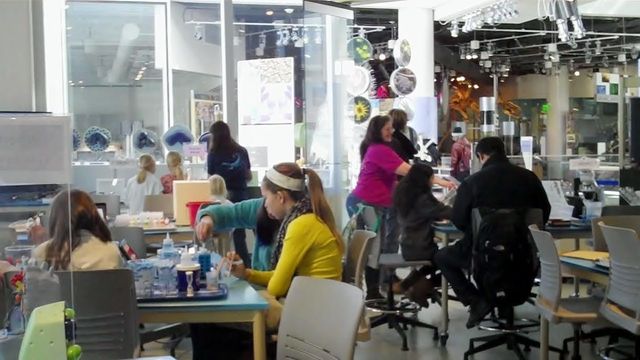Destination: Nature Research Center's Micro World Investigate Lab
Here, visitors can don white lab coats and get busy with experiments that have them figuring out which fictitious twin has peanut allergies, for instance, or which frog suffers from a fungus.
Posted — UpdatedHere, visitors can don white lab coats and get busy with experiments that have them figuring out which fictitious twin has peanut allergies, for instance, or which frog suffers from a fungus. They work with equipment such as centrifuges, vortex mixers, micropipettes and research-level microscopes - all equipment used in actual research labs around the world.
And they are investigating the tiniest of things, said Deb Bailey, the lab's co-coordinator.
"We're talking about little itty bitty things that can be anything from chemicals to microscopic organisms to biotechnology where the process is taking place on a micro or nano level," Bailey said.
The goal here is to get visitors, especially kids, familiar with the tools and trade of scientists. Maybe, after spending mornings at the Nature Research Center, they'll consider a career in science for themselves. At the very least, they'll be familiar with the work that researchers do and develop an appreciation for it.
"It's demystifying it and taking the fear out," said Bailey, who started her career in medical laboratory technologies, working in hospital labs.
All three are open to the public and provide hands-on activities. While the center's exhibits were designed originally with middle school and high school students in mind, lab staff work to include all ages in many of the activities.
In the Micro World lab, for instance, my five-year-old enjoyed the micropipette station, where she can create designs using the tool and colored water. Meanwhile, her nine-year-old sister got involved in a project extracting DNA from wheat cells.
Some visitors spend a few minutes in the lab, Bailey said. Others will spend a couple of hours. On Thursday, my crew of three kids - ages 9, 9 and 5 - happily worked away on projects for nearly an hour before they were ready to move on.
"People can select their experience," Bailey said. "Every person takes away what they are ready for."
Young kids, like my five-year-old, might come away learning about the importance of following instructions when working on science projects. Older kids might take away more complex topics such as scientific controls.
The experiments are switched out from time to time. Staff often develops seasonal activities tied to holidays.
If kids don't have the patience for a full experiment, they can look at the counters that line the outside wall. There, they'll find a fish tank with snails and fish; a forest terrarium and a bonzai tree named Fred, who is alive thanks to visitors' constant watering.
"This is our playroom," Bailey said. "We get to pursue anything we like that we are interested in. We want people to have a good time and have fun."
She hopes kids from all backgrounds will come away from the exhibit with a better understanding of what scientists do. Science careers don't always require years of school, she said. Many jobs require a one-year certification or associate's degree, Bailey said.
"We're really making it our mission to reach all kids and people from all backgrounds," she said.
The lab's hours vary depending on whether classes are scheduled in the space. Hours generally are 10 a.m. to 4 p.m., Tuesday through Saturday; 1 p.m. to 4 p.m., Sunday; and 10 a.m. to 1 p.m., Monday. Check with the Nature Research Center's main desk to get the day's hours for the lab. (It will be closed in the morning for a class this Saturday, Feb. 21).
If you plan on going to the lab during your visit to the Nature Research Center, it's best to get there early in the day if you're going on a Saturday or on any day during the summer. By the afternoon, it can be pretty packed.
The lab also hosts game nights with everything from Candy Land to Oceanopoly on the third Thursday night of each month and science-related talks on other Thursday evenings.
The Nature Research Center is at 121 W. Jones St., downtown Raleigh. Admission to the center and the lab are free.
Related Topics
• Credits
Copyright 2024 by Capitol Broadcasting Company. All rights reserved. This material may not be published, broadcast, rewritten or redistributed.






